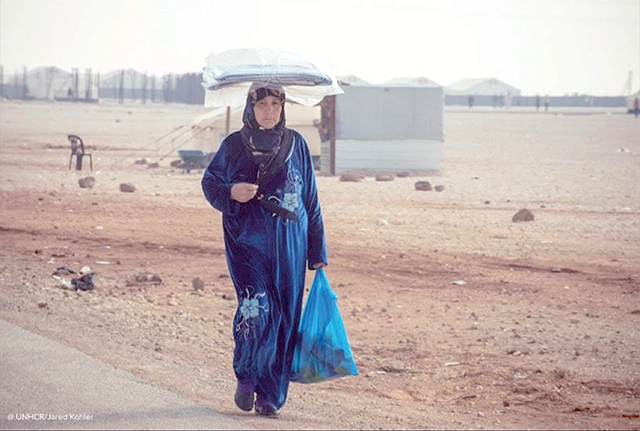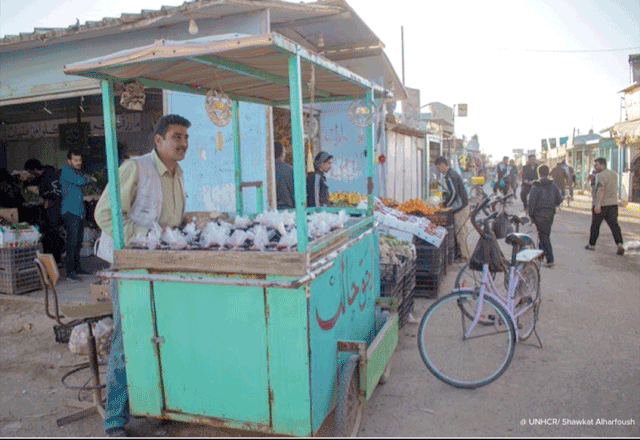You are here
Refugees disproportionately suffer from last 3 years of global shocks — UNHCR report
By Mays Ibrahim Mustafa - Jun 21,2023 - Last updated at Jun 21,2023

Refugees have been disproportionately impacted by the global shocks witnessed by the world over the past three years, according to recent study by the UNHCR, the UN Refugee Agency (Photo courtesy of UNHCR)
AMMAN — Refugees have been disproportionately impacted by the global shocks witnessed by the world over the past three years, according to recent study by the UNHCR, the UN Refugee Agency.
The study, published in June 2023, is titled “Exacerbating vulnerabilities: Where do global shocks leave refugees in Jordan?”
Loss of jobs during the pandemic
While COVID-19 pandemic resulted in job losses within both Syrian and Jordanian households, “Syrian refugees regained their employment at a slower pace than the Jordanian population,” the report said.
It included a survey showing that the rate of working Jordanian heads of household decreased from 49 per cent before the pandemic to 32 per cent by March 2021. By April 2022, this figure stood at 46 per cent.
Pre-pandemic, 60 per cent of heads of Syrian refugee households were employed. This figure decreased to around 45 per cent by April 2022, according to the report.
“[C]onsidering that many of the Syrian refugees are working in the informal sector without job security, they were less likely to enjoy the same level of policy protection as Jordanians during the pandemic, including the bans on dismissals of employees,” the report stated.
High levels of debt
Income losses, combined with the increase in the cost of living following the Russian invasion of Ukraine, made it difficult for refugees to afford basic needs, causing many to fall further into debt in 2022, the report said.
“Nearly nine out of 10 [refugee] households reported being in debt in the last quarter of 2022,” the report added, noting that Syrian households in out-of-camp settings were more likely to report debt.
Refugees’ debt-to-income ratio, a measure of the ability to repay money owed, remained high throughout 2022, according to the report.
“The highest debt-to-income ratio observed was for non-Syrian refugees, for whom the debt was on average eight times higher than income, followed by Syrians out of camps and Syrians in camps,” it stated.
Negative coping strategies
The report pointed out that in the first quarter of 2022, around three out of five refugee households in Jordan reported using at least one “severe” coping strategy, including reducing non-food expenses and accepting high-risk jobs.
Households witnessed a slight recovery at the end of the year, but their vulnerability levels remained high, the report added.
It also showed that 65 per cent of non-Syrian and 66 per cent of Syrian refugee households outside of camps, as well as 55 per cent of Syrian households in camps, “reported using at least one crisis or emergency coping strategy”.
Moreover, the report noted that the “excessive” use of negative coping strategies among refugees is indicative of a high level of food insecurity.
“One possible explanation to the increase in food insecurity two years after the onset of the pandemic is that households initially adopted coping strategies to meet basic needs… but soon exhausted them, or they became less effective with continued use,” the report stated.
Coping strategies are temporary solutions that may result in negative consequences in the long run, especially if the economic situation of households doesn’t improve, according to the report.
Mental health
“Mental health may worsen with the exposure to traumatic events such as violence, persecution, and displacement, for which it is of particular concern to refugees. Additional stressors like the pandemic or high prices of food may have a significant impact, leading to conditions such as depression, anxiety or post-traumatic stress disorder,” the report said.
The report also noted that refugees living in camps reported lower levels of depression compared to those living outside camps, which is likely due to their community way of living combined with receiving different forms of assistance.
Related Articles
AMMAN — Ninety-three per cent of Syrian and 88 per cent of non-Syrian households in host communities are in debt, while over eight out of 10
AMMAN — The Jordan funding update issued by UNHCR, the UN Refugee Agency, shows that it has only obtained 15 per cent of its $390.1 million


















